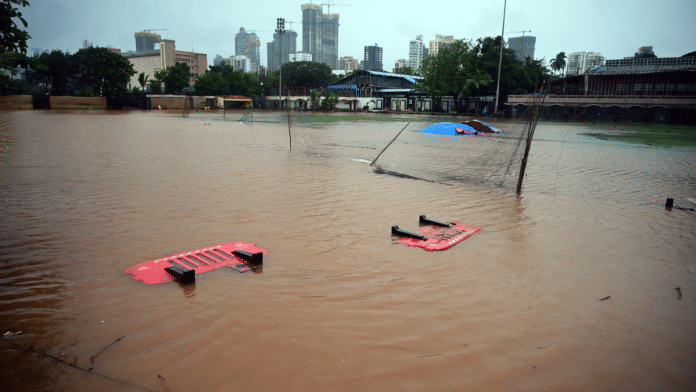Mumbai: Heavy rains in Mumbai accounted for more than 8 percent of deaths in the city during the monsoon season from 2006 to 2015, with slum dwellers worst hit, a new study has found.
The study published in the journal Nature on 12 November—titled ‘Mortality impacts of rainfall and sea-level rise in a developing megacity’—found that between 2,308 and 2,718 lives were lost in each year’s monsoon season, a death toll comparable to cancer deaths in the city.
According to the study, conducted by US and India-based researchers, 85 percent of the monsoon-linked deaths occurred in slums because they are located in low-lying, flood-prone areas, with women and children facing a higher risk of death. Mortality rates in non-slum areas are lower.
“Poor areas experience very different housing, sanitation and drainage systems compared to rich areas, and our most vulnerable are not able to access the resources and healthcare they need,” said co-author Archana Patankar, a climate change economist and founder of Mumbai-based Green Globe Consulting.
“A day with 150mm of rainfall causes a 2.9 percent increase in five-week mortality for slum residents, but only 1.2 percent increase for non-slum residents,” said the study.
The researchers counted deaths by drowning, electrocution, traffic disruptions, as well as flood-related diseases like dengue, diarrhoea, malaria and typhoid in the heavy rainfall-linked toll.
“With poor drainage and sanitation systems, standing floods can also trigger many aftereffects that don’t always make the headlines—diseases like dengue, diarrhoea, malaria can flourish, and more,” said co-author Ashwin Rode, director of scientific research at the Department of Economics at the University of Chicago.
Future risks
The study used data from the Mumbai municipal government’s death registration website from 2006 to 2015. Furthermore, the list of slum names in each of Mumbai’s 24 municipal wards from the 2001 census was also used.
By analysing the average age-wise monthly mortality rates from 2006 to 2015, the report concluded that children under the age of five years living in the slums are particularly vulnerable to waterborne diseases, like diarrhoea.
They account for up to 18 percent of the deaths during the monsoon season every year. Women, on the other hand, make up 11 percent of monsoon-related deaths.
The study pegged the mortality costs of heavy rainfall in Mumbai at approximately $1.2 billion. This includes economic costs and other damages from rainfall and flooding, including morbidity and economic impacts.
It also warned that if adequate steps are not taken, intensifying rainfall and rising sea levels as a result of global warming would lead to an about 20 percent increase in rainfall-linked deaths in the next 10 years. It said inadequate drainage systems in the populous city turned fatal as intense bursts of rain coupled with high tides led to issues such as flooding and waterlogging.
“Fortunately, these are problems that can be solved by leaders with targeted infrastructure, disaster management and healthcare changes,” said Patankar.
The study estimated that if sea levels rose by 5 cm, the mortality rate due to rainfall would increase to 9.1 percent, from a baseline of 8.5 percent, while a 15 cm rise would increase the figure to 10 percent.
The study concluded that climate change and worsening climate conditions are expected to lead to additional hazards, such as rising sea levels and higher rainfall in several parts of the world. This increases the urgency of intervention by local bodies to protect people.
“If policymakers and other stakeholders use this data to target investments and prepare our megacities for the changes ahead, we have the potential to create a safer and healthier future,” said Tom Bearpark, co-author of the study and a PhD student at Princeton University.
(Edited by Sugita Katyal)






